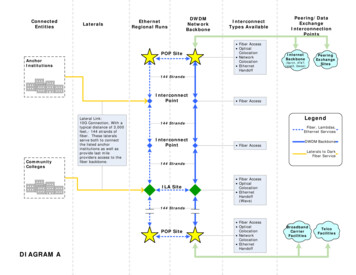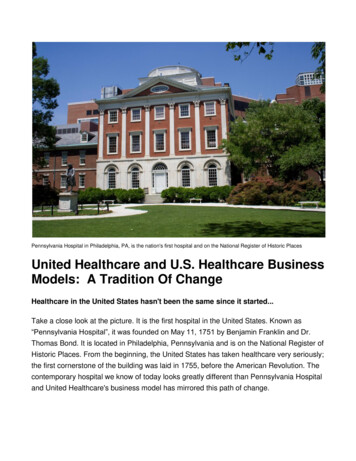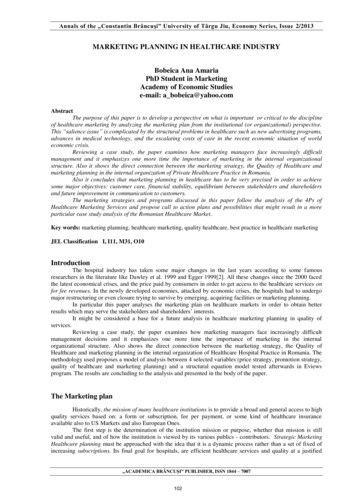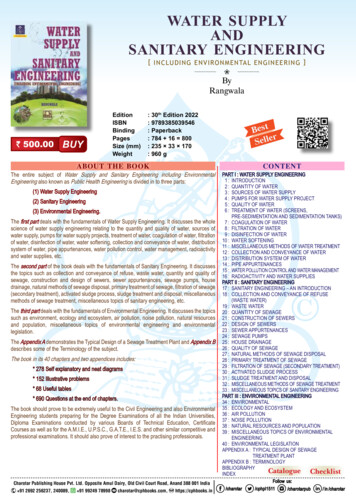
Transcription
Journal of Healthcare Engineering · Vol. 6 · No.4 · 2015 Page 635–648635Healthcare Engineering Defined: A White PaperMing-Chien Chyu, PhD1*; Tony Austin, PhD2; Fethi Calisir, PhD3; SamuelChanjaplammootil, ME4; Mark J. Davis, BSIE, LSSBB5; Jesus Favela, PhD6;Heng Gan, MBBCh, MRCPCH, FRCA7; Amit Gefen, PhD8; Ram Haddas, PhD9;Shoshana Hahn-Goldberg, PhD10; Roberto Hornero, PhD11; Yu-Li Huang,PhD12; Øystein Jensen13; Zhongwei Jiang, PhD14; J.S. Katsanis, PhD15; Jeong-ALee, PhD16; Gladius Lewis, PhD17; Nigel H. Lovell, PhD18; Heinz-TheoLuebbers, MD, DMD19; George G. Morales, BSME, MBA20; Timothy Matis,PhD21; Judith T. Matthews, PhD, MPH, RN22; Lukasz Mazur, PhD23; Eddie YinKwee Ng, Phd24; K.J. Oommen, MD25; Kevin Ormand, MSHA, PMP26; TaraldRohde27; Daniel Sánchez-Morillo, PhD28; Justo García Sanz-Calcedo, PhD29;Mohamad Sawan, PhD30; Chwan-Li Shen, PhD31; Jiann-Shing Shieh, PhD32;Chao-Ton Su, PhD33; Lilly Sun, PhD34; Mingui Sun, PhD35; Yi Sun, PhD36, SenayN. Tewolde, PhD37; Eric A. Williams, MD, MS, MMM38; Chongjun Yan, PhD39;Jiajie Zhang, PhD40; Yuan-Ting Zhang, PhD411.2.3.4.5.6.7.8.9.Professor, Department of Mechanical Engineering; Coordinator, HealthcareEngineering Graduate Program, Texas Tech University, Lubbock, Texas, USA.Helicon Health Ltd., London, UK.Professor, Industrial Engineering Department; Dean, Management Faculty,Istanbul Technical University, Turkey.Director of Facilities Operations and Maintenance, Texas Tech UniversityHealth Sciences Center - Permian Basin (Odessa, Midland, Abilene andDallas), Texas, USA.Operational & Clinical Excellence Leader, Texas Health Presbyterian Hospital,Dallas, Texas, USA.Professor, Computer Science Department, Center for Scientific Research andHigher Education of Ensenada, Ensenada, Mexico.Consultant Anaesthetist, Guy’s & St Thomas’ NHS Foundation Trust, King’sHealth Partners, London, UK.Professor, Department of Biomedical Engineering, Tel Aviv University, Israel.Director of Research, Texas Back Institute Research Foundation, Plano, Texas,USA.*Corresponding author: Ming-Chien Chyu, Department of Mechanical Engineering, Texas Tech University,Lubbock, Texas 79409-1021, USA. Phone: (806) 834-8982. E-mail: m.chyu@ttu.edu. Other JDavis@texashealth.org; favela@cicese.mx; heng.gan@gstt.nhs.uk; gefen@eng.tau.ac.il; nsen@ous-hf.no; jiang@yamaguchi-u.ac.jp; inmartek@otenet.gr; jalee@Chosun.ac.kr;glewis@memphis.edu; N.Lovell@unsw.edu.au; tluebbers@bwh.harvard.edu; george.morales@ttuhsc.edu;Timothy.Matis@ttu.edu; jtmatt@pitt.edu; lukasz mazur@med.unc.edu; MYKNG@ntu.edu.sg; OOMMENKJ@covhs.org; kormand@chartis.com; Tarald.Rohde@sintef.no; daniel.morillo@uca.es; justogarciasanz@gmail.com; mohamad.sawan@polymtl.ca; Leslie.Shen@ttuhsc.edu; jsshieh@saturn.yzu.edu.tw;ctsu@mx.nthu.edu.tw; lily.sun@reading.ac.uk; drsun@pitt.edu; yi.sun@uzleuven.be; ericw@bcm.edu; yanchongjun0607@163.com; Jiajie.Zhang@uth.tmc.edu; ytzhangapple@icloud.com.
636Healthcare Engineering Defined: A White Paper10. University Health Network, Toronto, Canada.11. Head of the Biomedical Engineering Group, E.T.S. Ingenieros deTelecomunicación, University of Valladolid, Valladolid, Spain.12. Mayo Clinic, Rochester, Minnesota, USA.13. Oslo University Hospital, Oslo, Norway.14. Professor, Department of Mechanical Engineering, Yamaguchi University, Japan.15. Professor, Department of Electrical and Computer Engineering, NationalTechnical University of Athens, Greece.16. Professor, Department of Computer Engineering, Chosun University, Korea17. Professor, University of Memphis, Memphis, Tennessee, USA.18. Scientia Professor, University of New South Wales, Graduate School ofBiomedical Engineering, Sydney, NSW Australia.19. Surgical Planning Laboratory, Brigham and Women’s Hospital, Boston, MA,USA; University Hospital and Center of Dental Medicine, University of Zurich,Zurich, Switzerland.20. Assistant Vice President, Physical Plant & Support Services, Texas TechUniversity Health Sciences Center, Lubbock, Texas, USA.21. Associate Professor, Department of Industrial Engineering, Texas TechUniversity, Texas, USA.22. Research Associate Professor, School of Nursing and University Center forSocial and Urban Research, University of Pittsburgh, Pittsburgh, USA.23. Director of Healthcare Engineering Division, School of Medicine, Universityof North Carolina – Chapel Hill, North Carolina, USA24. Professor, School of Mechanical & Aerospace Engineering, NanyangTechnological University, Singapore.25. Director, Epilepsy Clinics, Covenant Medical Group; Chief, Section of InternalMedicine, Covenant Hospital, Lubbock, Texas, USA.26. Principal, The Chartis Group, Chicago, Illinois, USA.27. SINTEF, Technology and Society, Hospital Planning, Oslo, Norway.28. Professor, Biomedical Engineering and Telemedicine Research Group,University of Cadiz, Spain.29. Professor, Extremadura Public Healthcare Service, University of Extremadura,Spain.30. Professor, Polystim Neurotechnology Lab, Polytechnique, University ofMontreal, Canada.31. Professor, Department of Pathology, School of Medicine, Texas Tech UniversityHealth Sciences Center, Lubbock, Texas, USA.32. Head, Department of Mechanical Engineering; Director, Institute ofMechanical Engineering, Yuan Ze University, Taiwan.33. Professor, Department of Industrial Engineering and Engineering Management,National Tsing Hua University, Hsinchu, Taiwan.34. Professor, School of Systems Engineering, University of Reading, UK.35. Professor, Department of Neurosurgery, Department of Electrical Engineering;Department of Bioengineering, University of Pittsburgh, Pittsburgh, PA, USA.36. Head of 3D Surgical Planning Lab – Oral and Maxillofacial Surgery,Department of Imaging & Pathology/OMFS-IMPATH Research Group,University Hospitals Leuven, Leuven, Belgium.37. Senior Research Engineer, HJF Advancement of Military Medicine, NavyMedical Research Unit, San Antonio, Texas, USA.
Journal of Healthcare Engineering · Vol. 6 · No. 4 · 201563738. Chief Quality Officer-Medicine, Texas Children’s Hospital; AssociateProfessor of Pediatrics, Sections of Critical Care and Cardiology, BaylorCollege of Medicine, Houston, Texas, USA.39. Professor, College of Management Science & Engineering, Dongbei Universityof Finance and Economic, Dalian, China.40. Dean, Glassell Family Foundation Distinguished Chair, Dr. Doris L. RossProfessor, School of Biomedical Informatics, University of Texas HealthScience Center at Houston, Houston, Texas, USA.41. Professor, The Chinese University of Hong Kong, China.Submitted August 2015. Accepted for publication October 2015.ABSTRACTEngineering has been playing an important role in serving and advancing healthcare. The term“Healthcare Engineering” has been used by professional societies, universities, scientific authors,and the healthcare industry for decades. However, the definition of “Healthcare Engineering”remains ambiguous. The purpose of this position paper is to present a definition of HealthcareEngineering as an academic discipline, an area of research, a field of specialty, and a profession.Healthcare Engineering is defined in terms of what it is, who performs it, where it is performed,and how it is performed, including its purpose, scope, topics, synergy, education/training,contributions, and prospects.Keywords: Healthcare engineering, definition, purpose, scope, topics, synergy, jobs, education,training, contributions, future1. PREAMBLEEngineering has been playing a crucial role in serving healthcare, bringing aboutrevolutionary advances in healthcare. Contributions have been made by engineers fromalmost all engineering disciplines, such as Biomedical, Chemical, Civil, Computer,Electrical, Environmental, Industrial, Information, Materials, Mechanical, Software, andSystems Engineering, as well as healthcare professionals such as physicians, dentists,nurses, pharmacists, allied health professionals, and health scientists who are engaged insupporting, improving, and/or advancing any aspect of healthcare through engineeringapproaches. “Healthcare Engineering” is the most appropriate term to encompass such amulti-disciplinary specialty, considering that advancing healthcare is the common goalfor all such efforts made through engineering approaches. However, so far, a clear,rigorous definition of “Healthcare Engineering” has never been documented.Established over 50 years ago, the American Society of Healthcare Engineering(ASHE) [1] was one of the first to publicize the term “Healthcare Engineering”. ASHE,as well as its many local affiliate societies (e.g., [2]), has been mainly dedicated to thehealth care physical environment, which represents only one sector of what engineers doin healthcare. David and Goodman [3] first used the term “healthcare engineers” in thescientific literature in 1989, where the critical role of the engineer in the healthcaredelivery system was discussed. A number of academic programs have adopted the term“Healthcare Engineering” in their names (e.g., [4–13]). However, thedescription/definition of “Healthcare Engineering” by these programs varies, as each
638Healthcare Engineering Defined: A White Paperinstitution has designed its program based on its own distinctive interest, strength, focus,and emphasis, and hence created a different description/definition accordingly. Each ofthese versions of description/definition excellently portrays a certain facet of HealthcareEngineering, though none reflects all dimensions of the discipline. Further, the Journal ofHealthcare Engineering [14], launched in 2010, focuses on engineering involved in allaspects of healthcare delivery processes and systems. “Healthcare Engineering” has alsoappeared in the commercial names of healthcare companies with various foci.The purpose of this document is to present a clear, rigorous definition of HealthcareEngineering as an academic discipline, an area of research, a field of specialty, and aprofession, as well as its prospects. The co-authors are all active members andcontributors to the Healthcare Engineering community from different parts of theworld. This document is based on our knowledge and experience accumulated throughyears of serving and promoting Healthcare Engineering.2. HEALTHCARE ENGINEERING DEFINEDHealthcare Engineering is defined in this section in terms of what it is, who performsit, where it is performed, and how it is performed.2.1. What2.1.1. DefinitionIn the short and straightforward version, “Healthcare Engineering” can be defined asfollows:Healthcare Engineering is engineering involved in all aspects of healthcare.The term “engineering” covers all engineering disciplines such as Biomedical,Chemical, Civil, Computer, Electrical, Environmental, Industrial, Information,Materials, Mechanical, Software, and Systems Engineering.A more elaborated definition can be developed based on “healthcare” defined as: “The maintenance and improvement of physical and mental health, especiallythrough the provision of medical services” [15]. “The prevention, treatment, and management of illness and the preservation ofmental and physical well-being through the services offered by the medical andallied health professions.” [16].Therefore, a more detailed definition of Healthcare Engineering is the following:Healthcare Engineering is engineering involved in all aspects of the prevention,diagnosis, treatment, and management of illness, as well as the preservation andimprovement of physical and mental health and well-being, through the servicesoffered to humans by the medical and allied health professions.2.1.2. PurposeThe purpose of Healthcare Engineering is to improve human health and well-beingthrough engineering approaches.2.1.3. ScopeHealthcare Engineering covers the following two major areas:
Journal of Healthcare Engineering · Vol. 6 · No. 4 · 2015639(I) Engineering for Healthcare InterventionThe U.S. Department of Health & Human Services (USDHHS) [17] defines “healthcareintervention” as “Any type of treatment, preventive care, or test that a person could takeor undergo to improve health or to help with a particular problem”. USDHHS furtherspecifies that healthcare interventions include drugs, foods, supplements, vaccinations,screening tests, exercises, hospital treatment, and certain kinds of care (such as physicaltherapy).(II) Engineering for Healthcare Systems“Healthcare system” is defined as: “The complete network of agencies, facilities, and all providers of health care ina specified geographic area” [18]. “Complex of facilities, organizations, and trained personnel engaged in providinghealth care within a geographical area.” [19].According to the World Health Organization (WHO) [20], a good health systemrequires “a robust financing mechanism; a well-trained and adequately paid workforce;reliable information on which to base decisions and policies; well maintained facilitiesand logistics to deliver quality medicines and technologies.”Therefore, the scope of Healthcare Engineering can be stated as the following:“Healthcare Engineering covers the following two major fields:I.Engineering for Healthcare Intervention: Engineering involved in thedevelopment or provision of any treatment, preventive care, or test that aperson could take or undergo to improve health or to help with a particularhealth problem.II. Engineering for Healthcare Systems: Engineering involved in the completenetwork of organizations, agencies, facilities, information systems,management systems, financing mechanisms, logistics, and all trainedpersonnel engaged in delivering healthcare within a geographical area.”2.1.4. SubjectsBased on the scope delineated above, the major subjects of Healthcare Engineering arelisted in Table 1. Each subject may have its own ramification system covering anumber of topics. For instance, within Biomechanics, there are Micro-biomechanicsand Macro-biomechanics. Micro-biomechanics further consists of Nanobiomechanics, Molecular Biomechanics, Cellular Biomechanics, and TissueBiomechanics, with each of them covering a number of topics or even furtherramifications. It is unnecessary and impractical for Table 1 to include all thosesubfields and topics for each subject. As technology progresses, new topics willemerge, while some old topics may become obsolete or be subsumed under others inthe future. If we list Healthcare Engineering topics in Table 1, there is no mechanismavailable for us to update them once this white paper is published in an archivaljournal. We recommend lists of topics provided and continually updated byauthoritative sources such as those leading societies/associations of individual subjectsand government organizations.
640Healthcare Engineering Defined: A White PaperTable 1. Healthcare Engineering subjects(I) Engineering for Healthcare InterventionA. Fundamentals1. Biomechanics2. Biomaterials3. Biomedical Instruments4. Medical Devices5. Engineering for Surgery6. Medical Imaging7. Organ Transplantation8. Artificial Organs9. Drug Delivery10. Genetic Engineering11. Engineering forDiagnosis/Detection12. Health Informatics, InformationEngineering & Decision Support13. Disinfection EngineeringB. Engineering for Disease Prevention,Diagnosis, Treatment, and Management1. Cardiovascular Disease2. Cancer3. Alzheimer’s Disease4. Diabetes5. Respiratory Disease6. Obesity7. Degenerative Diseases8. OthersC. Engineering for Patient Care1. Patient Safety2. Critical Care3. Neonatal Care4. Home Healthcare5. Elderly Care6. Patient Monitoring7. Health Disparities8. Disaster ManagementD. Engineering for Medical Specialties1. Allergy and Immunology2. 7.18.19.20.CardiologyCritical Care MedicineEmergency MedicineEndocrinologyGastroenterologyGeneral SurgeryGeriatricsInfectious DiseaseNeurologyNeurosurgeryNuclear MedicineOccupational ediatricsPhysical Medicine andRehabilitation21. Plastic, Reconstructive andAesthetic Surgery22. Public Health23. Pulmonology24. Radiology25. Radiotherapy26. Rheumatology27. Sports Medicine28. Urology29. Vascular MedicineE. Engineering for Dental Specialties1. Endodontics2. Oral and Maxillofacial Pathology,Radiology, and Surgery3. Orthodontics and DentofacialOrthopedics4. Periodontics5. Prosthodontics6. OthersF. Engineering for Allied Health Specialties1. Audiology2. Clinical Laboratory Science3. Environmental Health
Journal of Healthcare Engineering · Vol. 6 · No. 4 · 20154. Occupational Therapy5. Orthotics and prosthetics6. Physical Therapy7. Rehabilitation8. Respiratory Therapy9. Speech Therapy10. OthersG. Engineering for Nursing - including nursing in all related areas, particularly (I)B,C, D, E, (II)A, and B.H. Engineering for Pharmacy1. Pharmaceutical Design &Development2. Bio-/PharmaceuticalManufacturing3. Pharmaceutical Devices4. Pharmaceutical Testing5. Pharmaceutical InformationSystems6. Clinical Science7. Regulatory Compliance(II) Engineering for Healthcare SystemsA. Healthcare System Management,Improvement & Reform1. Quality, Cost, Efficiency,Effectiveness2. Operations Research & SystemsEngineering6413.Lean, Six Sigma, Total QualityManagement4. Human Factors5. High Reliability Organization6. Resilience Engineering7. Rural HealthB. Healthcare Information Systems1. Electronic Health Record2. E-Health3. M-Health4. Telemedicine5. Wireless Technology6. Data Mining & Big Data7. Information SecurityC. Healthcare Facilities1. Healthcare Infrastructure2. Healthcare Energy Systems3. Healthcare Sustainability &Green Design4. Environmental Health and SafetyD. Healthcare Policy(III) OthersA. Healthcare Engineering Education &Training1. Collegiate Education2. Continued EducationB. Future of Healthcare2.1.5. SynergyHealthcare Engineering includes the healthcare/medical sectors of all engineeringdisciplines, with an emphasis on the synergy of all these sectors and theengineering/technology sectors of the Health Sciences (medicine, dentistry, alliedhealth, nursing, pharmacy, public health, etc.), as depicted in Figure 1.2.2. Who2.2.1. DefinitionHealthcare Engineering professionals are mainly (a) engineers from all engineeringdisciplines such as Biomedical, Chemical, Civil, Computer, Electrical, Environmental,Industrial, Information, Materials, Mechanical, Software, and Systems Engineering,and (b) healthcare professionals such as physicians, dentists, nurses, pharmacists,allied health professionals, and health scientists, who are engaged in supporting,improving, and/or advancing any aspect of healthcare through engineeringapproaches, in accordance with the above definition of Healthcare Engineering. Sincesome healthcare professionals engaged in Healthcare Engineering may not beconsidered to be “engineers”, “Healthcare Engineering professional” is a moreappropriate term than “Healthcare Engineer”.
642Healthcare Engineering Defined: A White PaperEngineering(Biomedical, Chemical, Civil,Computer, Electrical, Environmental,Industrial, Information, Materials, Mechanical,Software, System, etc.)Health sciences(Meidicine, Dentistry,Allied Health,Nursing, Pharmacy,Public Health, etc.)Figure 1.Healthcare engineering(Healthcare/medical sectors of allengineering disciplines engineering/technology sectors of healthsciences)Healthcare Engineering: synergy of engineering and health sciences. Redblock: All engineering disciplines. Green block: All health sciencesdisciplines. Blue block: All Healthcare Engineering disciplines.2.2.2. Education & TrainingEngineers from various engineering disciplines are always in demand in healthcare, asthe engineering issues in healthcare require the expertise of specific engineeringdisciplines. It is a common misconception that only engineers with a background inBiomedical Engineering, Clinical Engineering, or related areas may work inhealthcare. However, a major issue is that most existing engineering curricula(particularly undergraduate ones) do not cover sufficient healthcare content, exceptthose in the bio-related areas. There is a need for courses that can fill the gap and betterprepare non-biomedical engineering students for service in healthcare. There is also aneed for certificate programs that can help practicing engineers transition from othersectors of industry to healthcare which is one of the world’s largest and fastestgrowing industries. On the other hand, healthcare professionals (physicians, dentists,nurses, pharmacists, allied health professionals, etc.) need to be better trained to applyengineering to their practice, problem solving, and advancing healthcare. Due to therapid advance of technology, continuing education plays a crucial role in keepingHealthcare Engineering professionals abreast of such advancement and ensuring theircontinued competence, be they trend followers or innovation leaders. Additionally,since the nature of Healthcare Engineering often requires inter-disciplinary or eveninter-professional collaboration among varied disciplines of both healthcare andengineering, there is a need for learning opportunities that develop students’ keycompetencies for working with Healthcare Engineering professionals in the real world,such as through joint projects between universities and hospitals.
Journal of Healthcare Engineering · Vol. 6 · No. 4 · 20156432.3. WhereHealthcare Engineering activities generally take place within or surrounding thehealthcare industry. In other words, the purpose of Healthcare Engineering is achievedby professionals working in/with/for the healthcare industry. A description of thehealthcare industry affords a better understanding of the types of Healthcare Engineeringjobs, the roles played by Healthcare Engineering professionals, the importance ofHealthcare Engineering, and Healthcare Engineering professionals’ contributions tosociety. Although individuals working on Healthcare Engineering in universities,research institutions, government agencies, and other non-industrial organizations maynot be working within the healthcare industry per se, they typically collaborate with orwork for some sectors of the healthcare industry, or make results of their works availablethrough publications for the healthcare industry’s adoption, in order for their work tobenefit human health.The healthcare industry is one of the world’s largest and fastest-growing industries,and could even be the largest industry in the world [21], and the fastest-growingindustry in the US [22]. Healthcare industry is defined as [23]:“The complex of preventive, remedial, and therapeutic services provided byhospitals and other institutions, nurses, doctors, dentists, medical administrators,government agencies, voluntary agencies, noninstitutional care facilities,pharmaceutical and medical equipment manufacturers, and health insurancecompanies.”Based on the framework of the Industry Classification Benchmark (ICB) [24], adefinitive system categorizing over 70,000 companies and 75,000 securities worldwideand one of the most widely adopted such standards in the business community, majorsectors and subsectors of healthcare industry are presented in Table 2. The original ICBclassification is changed as we deem appropriate; for instance, a sector of healthcareconsulting, support, and education, and a subsector of healthcare systems have beencreated.2.4. HowHealthcare Engineering professionals perform their jobs in/with/for the healthcareindustry. Their contributions to various sectors and subsectors of the healthcare industryare summarized in Table 2.3. PROSPECTSThe healthcare industry is expected to remain to be one of the world’s largest andfastest-growing industries, and the demand for Healthcare Engineering professionalswill continue to grow accordingly. As healthcare changes rapidly and becomesincreasingly complex under technological, economic, social, and regulatory impacts, itis anticipated that Healthcare Engineering will play a role of growing importance inalmost every aspect of healthcare, and will also be a major factor that advanceshealthcare. Healthcare Engineering professionals will face challenges associated withissues such as the continued rise in healthcare costs, the quality and safety of healthcare,
644Healthcare Engineering Defined: A White PaperTable 2. Healthcare industry classification and contributions ofHealthcare EngineeringHealthcare IndustryContributions of thcareservices,equipment,and systemsHealth careprovidersHealth maintenanceorganizations, hospitals,clinics, dentists, alliedhealth providers, opticians, nursing homes,rehabilitation facilities,retirement centers, andhome healthcareproviders.Healthcare Engineeringprofessionals play keyroles in creating and developing hardware and software to innovate, support,improve and optimize theoperation processes andsystems of patient care,and to improve patient outcomes through s and distributors of medicalinstruments (e.g., bloodpressure monitor), medical devices (e.g., surgical robot), imagingmachines (e.g., X-ray,MRI), artificial organs,and other non-disposable medical devices aswell as medical software.This is an area heavilyrelying on engineeringexpertise, and whereHealthcare Engineeringprofessionals make majorcontributions in basicresearch that leads totechnology breakthroughs,as well as subsequentdesign, development, andmanufacturing of medicaldevices and equipment.MedicalsuppliesManufacturers and distributors of medical supplies used by health careproviders and the generalpublic, including makersof implants, contact lenses, eyeglass lenses, bandages and other disposable medical supplies.Healthcare Engineeringprofessionals contribute tothe research & development of new products andmanufacturing in terms ofprocess design, machinery,automation, quality control, and cost reduction.
Journal of Healthcare Engineering · Vol. 6 · No. 4 · 2015Pharmaceuticals andbiotechnologyHealthcareconsulting,support, andeducation645HealthcaresystemsCompanies that specialize in healthcare systemsincluding facilities,information, financial,and other systems.Healthcare Engineeringprofessionals work withhealthcare providers todesign, construct, improve,and/or operate healthcarefacilities, information,financial, and other healthcare systems, followingspecial regulations.BiotechnologyCompanies engaged inresearch into and development of biologicalsubstances leading tonew drugs and/or medical procedures.Healthcare Engineeringprofessionals lead or participate in research anddevelopment of cuttingedge technologies for newdrugs (including drug discovery, design, development, and delivery) andadvanced medical procedures for the prevention,diagnosis, treatment, andmanagement of illnesses.PharmaceuticalsManufacturers of prescription or over-thecounter drugs, such asaspirin, cold remedies andbirth control pills, including vaccine producers.Healthcare Engineeringprofessionals contribute tothe pharmaceutical manufacturing processes interms of process design,unit operation, quality control, and cost reduction.Companies that provideconsulting service andsupport to healthcare,as well as continuededucation to healthcarepersonnel.Healthcare Engineeringprofessionals provide consulting service, support,and education on allaspects of healthcareinvolving engineering,such as optimizing healthcare operations, solvingproblems, providing informatics service, as well asdesigning, planningand/or executing new projects.
646Healthcare Engineering Defined: A White Papercare of the aging population, management of common diseases, the impact of hightechnology, increasing demands for regulatory compliance, risk management, andreducing litigation risk. They will play a key role in creating, developing, andimplementing cutting-edge devices and systems attributed to advances in electronics,information technology, miniaturization, material science, optics, and other fields. Astechnology continues to create new areas for engineers to work in healthcare, and thefusion of engineering with health sciences leads to a greater demand for engineers,Healthcare Engineering will be recognized as the most important profession whereengineers make major contributions directly benefiting human health.4. CONCLUDING REMARKSIn presenting a definition of Healthcare Engineering as an academic discipline, an areaof research, a field of specialty, and a profession, we expect this document to haveimpacts in terms of the following: Raising the status and visibility of Healthcare Engineering. Helping students choose Healthcare Engineering-related fields as majors. Helping engineers and healthcare professionals choose Healthcare Engineering asa profession. Defining Healthcare Engineering as a specialty area for the research community,funding agencies, and conference/event organizers. Helping job searching databases properly categorize Healthcare Engineering jobs. Helping healthcare employers recruit from the right pool of expertise. Bringing academic administrators’ attention to Healthcare Engineering inconsidering new program initiations. Helping governments and institutions of different levels put HealthcareEngineering into perspective for policy making, budgeting, and other purposes. Helping publishers and librarians categorize literature related to HealthcareEngineering.It is our humble belief that this document will serve as a cornerstone for thedevelopment of Healthcare Engineering in decades to come.ACKNOWLEDGEMENTSWe would like to thank more than 280 reviewers, including members of US NationalAcademy of Engineering, Engineering Deans of the world’s top universities,administrators and faculty members of Healthcare Engineering academic programs,leaders of healthcare/medical and engineering professional societies/associations,le
Journal of Healthcare Engineering· Vol. 6 · No.4 · 2015 Page 635-648 635 Healthcare Engineering Defined: A White Paper . 37. Senior Research Engineer, HJF Advancement of Military Medicine, Navy Medical Research Unit, San Antonio, Texas, USA. . 39. Professor, College of Management Science & Engineering, Dongbei University of Finance and .










